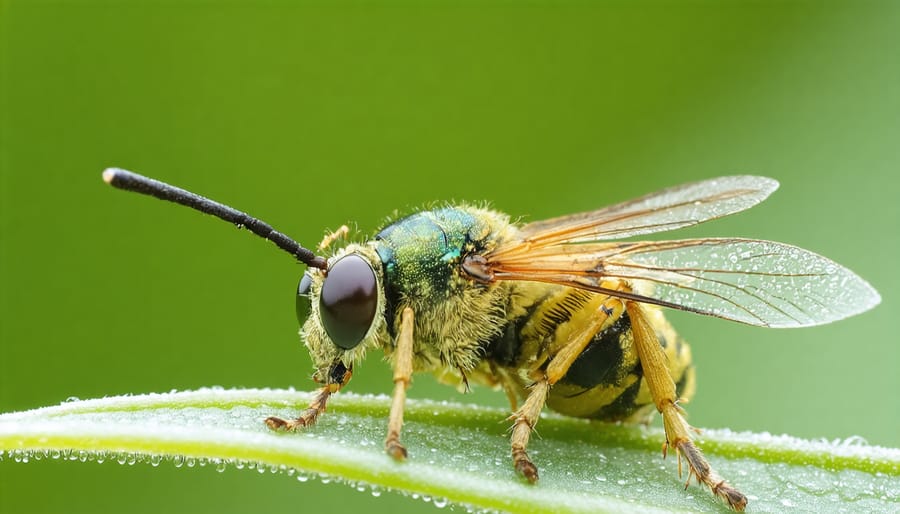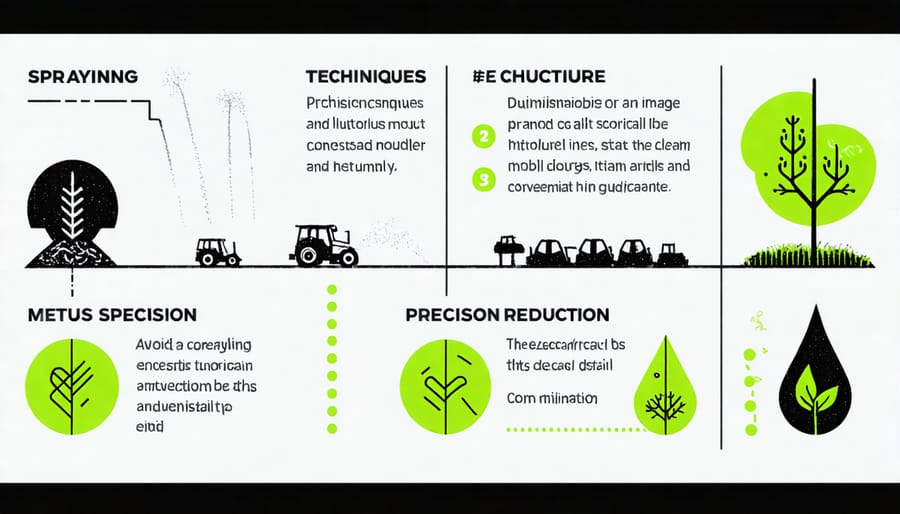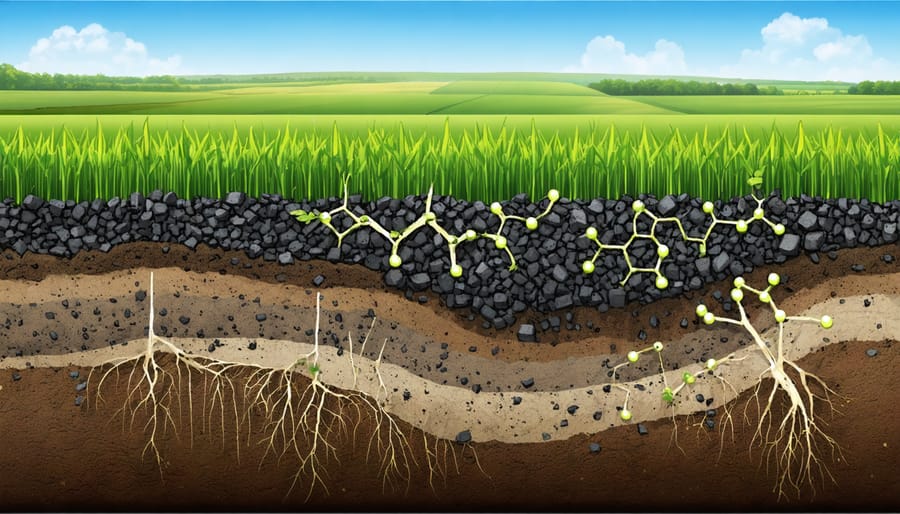Transform your farm’s pest management strategy by integrating natural pest control methods with advanced monitoring systems and biodiversity enhancement. Alberta farmers reduce pesticide use by 40% through strategic crop rotation, beneficial insect corridors, and precision monitoring technologies – achieving both environmental sustainability and profitable yields.
Mounting pressure from climate change and evolving pest resistance demands a shift from conventional pest control to regenerative practices. Our comprehensive roadmap, developed alongside Alberta’s leading agricultural experts and successful organic farmers, delivers a practical framework for transitioning to sustainable pest management while maintaining crop productivity.
This evidence-based approach combines traditional ecological knowledge with cutting-edge agricultural innovation, specifically tailored to Alberta’s unique growing conditions. By implementing these strategies, farmers across the province have documented significant improvements in soil health, reduced input costs, and enhanced crop resilience – all while meeting stringent export market requirements for reduced chemical residues.
The Building Blocks of Alberta’s Sustainable Pest Management
Understanding Your Farm’s Ecosystem
Your farm is more than just a collection of fields and crops – it’s a living ecosystem where countless species interact daily. In Alberta’s diverse agricultural landscape, understanding these relationships is crucial for effective pest management. From beneficial insects like ladybugs and ground beetles that naturally control aphid populations, to native birds that keep grasshopper numbers in check, your farm hosts numerous allies in pest control.
Start by mapping your farm’s biodiversity hotspots – windbreaks, field margins, and natural areas that serve as habitat for beneficial insects. These areas act as natural barriers against pest invasions and provide year-round shelter for your pest-fighting partners. Look for signs of healthy biodiversity, such as varied plant species, different types of pollinators, and the presence of predatory insects.
Consider conducting seasonal biodiversity surveys to track the populations of both pest and beneficial species. This information helps you make informed decisions about when intervention is necessary and when natural controls are effectively managing pest issues. Remember that a balanced ecosystem often self-regulates, reducing the need for external pest control measures.
Many Alberta farmers have found that maintaining diverse field edges with native plants strengthens their farm’s natural pest resistance while supporting local wildlife.
Climate-Smart Pest Monitoring
Modern pest monitoring in Alberta has evolved to embrace climate-smart farming practices that account for our unique weather patterns and changing seasonal conditions. Using a combination of digital sensors, weather stations, and mobile apps, farmers can now track pest populations with unprecedented accuracy while considering temperature fluctuations and precipitation levels specific to their location.
Remote monitoring systems allow for early detection of pest outbreaks by analyzing data patterns and environmental conditions that typically precede infestations. These systems can alert farmers via smartphone notifications when conditions become favorable for specific pest species, enabling proactive rather than reactive management strategies.
Collaborative monitoring networks between neighboring farms have proven particularly effective in Alberta, creating an early warning system that benefits entire agricultural communities. By sharing real-time data about pest movements and population densities, farmers can coordinate their response efforts and optimize the timing of control measures.
This modern approach to monitoring integrates historical weather data with current conditions to predict pest behavior patterns, helping farmers make informed decisions about when and where to implement control measures.
Prevention-First Strategy

Crop Rotation Success Stories
The Friesen family farm in Crossfield has been a shining example of successful crop rotation for pest management since implementing their four-year rotation plan in 2018. By alternating between canola, wheat, peas, and barley, they’ve reduced their pesticide use by 40% while maintaining robust yields. “The key was patience and careful planning,” says Sarah Friesen. “We saw the biggest improvements in our third year when pest populations notably declined.”
In the Medicine Hat area, the Rodriguez brothers transformed their 800-hectare operation by introducing mustard as a biofumigant crop in their rotation. This strategic move helped them combat wireworm infestations naturally, resulting in a 35% reduction in chemical inputs and a 15% increase in wheat yields over three years.
The Sustainable Rotation Initiative in Leduc County showcases another success story. Five participating farms collaborated on a synchronized rotation schedule, creating larger zones of non-host crops for prevalent pests. This community approach led to a remarkable decrease in flea beetle pressure across the entire area, with participating farms reporting 45% fewer outbreaks compared to previous years.
Near Red Deer, the Hansen farm’s innovative six-year rotation incorporating cover crops has become a model for integrated pest management. Their system includes strategic use of fall rye and clover, creating habitat for beneficial insects while disrupting pest lifecycles. This approach has helped them maintain consistent yields while reducing pest management costs by 30%.
Building Resilient Soil Systems
Building resilient soil systems starts with understanding and nurturing soil biodiversity, which forms the foundation of natural pest resistance. Here in Alberta, successful farmers have found that healthy soil acts as their first line of defense against pest problems.
Start by implementing regular soil testing to monitor organic matter content, nutrient levels, and beneficial microorganism populations. Aim for organic matter levels of 4-6% through practices like crop rotation and cover cropping. Include crops like clover and alfalfa in your rotation to naturally boost nitrogen levels and improve soil structure.
Minimize tillage operations to protect soil structure and beneficial organisms. Many Alberta farmers have successfully adopted strip-till or no-till methods, reporting improved pest resistance within 2-3 growing seasons. Adding organic amendments like well-composted manure (10-15 tonnes per hectare annually) helps build lasting soil health.
Maintain year-round soil coverage using cover crops or crop residue. This practice not only prevents erosion but also creates habitat for beneficial insects and organisms that naturally control pest populations. Local success stories show that farms using these methods have reduced pesticide use by 30-40% while maintaining or improving yields.
Remember that building resilient soil is a long-term investment. While changes may take time to show results, the benefits of reduced pest pressure and improved crop health make it worthwhile for your farm’s future.
Integration of Biological Controls
Native Beneficial Species
Alberta’s agricultural landscape is home to numerous beneficial insects that naturally support pest control efforts. Ladybugs, lacewings, and parasitic wasps are particularly effective at controlling aphids and other crop-damaging pests. Ground beetles, which thrive in our prairie soils, help manage slugs and various crop-eating insects.
To attract these helpful allies, consider planting native flowering species like yarrow, golden rod, and purple coneflower around field margins. These plants provide essential nectar and pollen throughout the growing season. Creating beetle banks – raised strips of native grasses and perennial plants – offers excellent overwintering habitat for beneficial insects.
Many Alberta farmers have found success by maintaining diverse hedgerows and establishing wildflower corridors between crop fields. These features not only support beneficial insect populations but also create natural windbreaks and enhance overall farm biodiversity.
Leaving small areas of unmowed vegetation during winter provides crucial shelter for these insects. Studies at Alberta research stations have shown that farms maintaining at least 5% of their land as natural habitat see significantly higher beneficial insect populations and improved natural pest control.
Remember that beneficial insects work best as part of an integrated pest management strategy, complementing other sustainable practices while reducing the need for chemical interventions.

Microbial Solutions
Beneficial microorganisms are becoming increasingly important in Alberta’s sustainable pest management practices. These naturally occurring allies work by either directly competing with pest organisms or strengthening plants’ natural defence mechanisms. Local farmers have reported significant success using Bacillus thuringiensis (Bt) for controlling caterpillar pests in canola fields, while Trichoderma species have proven effective against soil-borne pathogens in pulse crops.
Recent field trials in Southern Alberta demonstrate that introducing beneficial fungi like Beauveria bassiana can reduce grasshopper populations by up to 70% without harming beneficial insects. These microbial solutions are particularly valuable because they’re specific to target pests and leave minimal environmental impact.
To implement microbial controls effectively, timing is crucial. Early spring application of beneficial nematodes can help manage root-feeding insects, while regular applications of mycorrhizal fungi throughout the growing season enhance plant resilience. Many of these solutions are now available through local agricultural suppliers and can be integrated with existing farming practices.
For best results, store microbial products according to label instructions and apply during cooler hours to ensure maximum survival rates. Consider starting with small-scale trials to understand how these solutions work best in your specific field conditions.
Chemical Use optimization

Smart Application Techniques
Smart application techniques combine precision and timing to maximize pest control while protecting our environment and reducing costs. In Alberta’s diverse agricultural landscape, farmers are finding success with targeted spraying methods that use GPS technology and digital mapping to identify specific problem areas. This approach can reduce pesticide use by up to 30% compared to broadcast spraying.
Consider implementing spot treatments during optimal weather conditions – typically early morning or late evening when wind speeds are below 15 km/h and temperatures range between 10-25°C. These conditions minimize drift and maximize effectiveness. Using drift-reducing nozzles and maintaining proper boom height (50-60 cm above the target) further enhances application accuracy.
Many Alberta farmers are adopting the “4R” principle: Right product, Right rate, Right time, Right place. For example, local farmer Sarah Thompson reduced her pesticide use by 25% by switching to electrostatic sprayers that improve coverage while using less product. Regular equipment calibration and maintenance ensure consistent application rates and prevent waste.
Remember to maintain detailed application records, including weather conditions, application rates, and observed results. This data helps refine future applications and demonstrates due diligence in sustainable pest management practices.
Alternative Solutions First
When tackling pest challenges, start by exploring non-chemical solutions before reaching for pesticides. Begin with a thorough field assessment to identify the specific pest and understand its lifecycle. Consider implementing cultural controls like crop rotation, adjusting planting dates, or using trap crops that work well in Alberta’s climate.
Next, evaluate biological control options such as beneficial insects native to our region. Many Alberta farmers have found success with parasitic wasps for controlling caterpillars and ladybugs for managing aphid populations. Physical barriers like row covers and mechanical controls like targeted tillage can also provide effective pest management while maintaining soil health.
Establish clear thresholds for pest damage that trigger intervention. Monitor pest populations regularly and document the effectiveness of different control methods. Consider working with neighbouring farms to create buffer zones and share successful management strategies.
Remember, sustainable pest management isn’t about eliminating all pests but maintaining them below economically damaging levels. If non-chemical methods prove insufficient, then consider integrating selective pesticides as part of your broader management strategy.
Measuring Success and Adaptation
Tracking the success of your sustainable pest management strategy is crucial for long-term effectiveness and continuous improvement. Start by establishing clear baseline measurements of pest populations, crop damage levels, and beneficial insect presence before implementing new management practices. Document these metrics using detailed field notes, photographs, and pest monitoring cards.
Consider implementing a seasonal monitoring schedule that includes weekly pest scouting during critical growth periods. Record key data points such as pest identification, population density, crop damage percentage, and weather conditions. Many Alberta farmers find success using digital apps or specialized software to streamline this process and maintain consistent records.
Economic indicators are equally important. Track input costs, labour hours, and yield data to evaluate the financial impact of your sustainable pest management practices. Compare these figures with previous seasons to determine cost-effectiveness and return on investment.
Adaptation is vital in our changing climate. Review your data quarterly and annually to identify patterns and areas for improvement. Be prepared to adjust your strategies based on:
– Pest resistance development
– Changes in weather patterns
– New pest species emergence
– Effectiveness of biological controls
– Crop rotation results
Connect with local agricultural extension services and fellow farmers to share experiences and learn from collective successes and challenges. Many Alberta producers participate in regional monitoring networks, contributing to a broader understanding of pest management effectiveness across the province.
Remember that sustainable pest management is an evolving process. Use your measurements to refine your approach, but maintain flexibility to respond to changing conditions and new research findings.
As we’ve explored throughout this roadmap, sustainable pest management is not just an environmental choice – it’s a smart business decision for Alberta farmers. By implementing these integrated approaches, you’re not only protecting your crops but also building resilience into your farming operation for generations to come.
The success stories from fellow Alberta farmers demonstrate that sustainable pest management is both practical and profitable in our unique climate. From reducing chemical inputs to embracing beneficial insects and implementing crop rotation strategies, each step you take builds towards a more sustainable future for agriculture in our province.
Remember that transition doesn’t happen overnight. Start with small, manageable changes and gradually expand your sustainable practices as you gain confidence and experience. The support network of agricultural extension services, local farming communities, and research institutions across Alberta stands ready to assist you on this journey.
By monitoring results, sharing experiences with neighbours, and staying informed about new sustainable techniques, you’ll continue to refine and improve your approach. The future of farming in Alberta depends on our collective commitment to sustainable practices that protect both our agricultural productivity and our environmental heritage.
Take the first step today. Whether it’s establishing monitoring protocols, planning your crop rotation, or consulting with local experts, your actions contribute to a more sustainable and prosperous agricultural future for Alberta.










